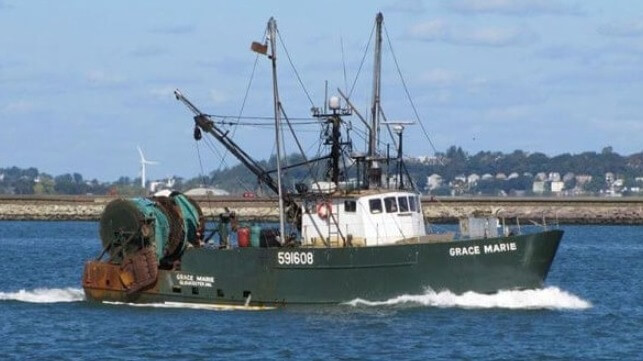NTSB: Inadequate Repair Led to Sinking of Fishing Vessel Grace Marie

The National Transportation Safety Board (NTSB) has concluded its investigation into the sinking of the fishing vessel Grace Marie last year, and has concluded that an inappropriate hull repair was the likely source of the flooding that sent her to the bottom.
On July 6, 2022, the 45-year-old trawler Grace Marie got under way from Gloucester, Massachusetts and headed to her fishing grounds, located about 75 nm to the east. Her captain and crew had decades of experience, including many years aboard the same vessel.
After two days of fishing, the Grace Marie's hold was nearly full, and the captain got under way for the next location. At about 2150, the engine room bilge alarm sounded in the wheelhouse. This was routine, as water would accumulate from the stuffing box, overflow from the fish hold, and gray water from the vessel's sinks (the drain lines were routed into the bilge). A deckhand had been in the engine room to refill a fuel service tank a few minutes earlier, and he said that he saw nothing unusual. The captain started one of the space's three bilge pumps remotely and carried on.
At 2200, the engine room's high-high bilge alarm sounded, indicating that the water level was still rising. This was out of the ordinary, and the captain went to investigate with a deckhand. Both saw water rising steadily in the engine room's bilges, but they could not find the source of the leak. The captain started the other two bilge pumps and closed both of the boat's seacocks as a precautionary measure. However, the water continued to rise.
The captain ordered the crew to prepare to abandon ship, and at 2210 the Grace Marie put out a mayday call. A nearby fishing vessel, the Dawn T, responded quickly and began a short transit to meet them. The crew all abandoned ship into a life raft at 2220, and the good samaritan vessel had them all aboard by 2234.
The crew remained on scene near their stricken boat for two hours, and saw Grace Marie take on a starboard list. At 0048, the vessel's lights went out, and Dawn T departed and headed for her home port. The Grace Marie's float-free EPIRB activated automatically at 0241, giving a good indication of the time and location of her sinking. A U.S. Coast Guard overflight confirmed the presence of a 350- by 150-foot oil sheen at the EPIRB coordinates after daybreak.
No injuries were reported, but the vessel was a total loss, and was not salvaged or surveyed. The value of the loss was estimated at about $650,000.
After the sinking, NTSB began an investigation into the Grace Marie's sinking. (Commercial fishing vessel casualties are among NTSB's top priorities.) The vessel's last U.S. Coast Guard safety-gear inspection in 2020 had not found any deficiencies, and a 2018 hull survey found that the bottom was "in overall good condition for a vessel of its age." The crew had seen nothing wrong with the stuffing box, which had been operating normally.
NTSB's inspectors honed in on an item in the 2018 survey: the vessel had two 3/8" thick doubler plates on each side of the keel. These had been welded on about 8-10 years before the sinking because the hull condition in that area was "a little spotty," according to the owner. The vessel's master told investigators that "it was all doubler plate" under the engine room.
Doubler plate is permitted for temporary and permanent repairs aboard uninspected fishing vessels, but it is not recommended best practice, according to the Coast Guard. The USCG warns that doubler plates can concentrate hull stresses in the area of the repair, and also prevents inspection of the condition of the hull underneath. The Coast Guard generally finds that "where doublers have been used, they tend to proliferate as randomly placed patches which often serve only to cover up the deficiencies which would otherwise indicate the true condition of the hull." Instead, the service recommends cropping out wasted steel plate back to good material and installing new plate to bring the vessel back to specification.
Ruling out other possible explanations, NTSB concluded that the vessel likely went down because of "a failure of the doubler-plated hull below the engine room." The agency noted that doubler plates are common on uninspected fishing vessels, and advised that they are "not generally suitable as a permanent repair for a vessel's hull."
